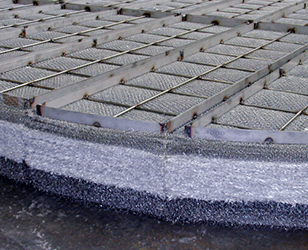
Droplet separation
Effective, optimally designed droplet separation removes contaminants and unwanted substances in various air or gas streams.
Droplet separation also prevents damage and corrosion to pipes, compressors and other process equipment. It also enables product recycling. A well designed solution leads to increased process efficiency, energy and cost savings, and reduced environmentally hazardous emissions.

How does droplet separation work?
The principle of droplet separation is that the droplets in an air or gas flow collide with the surface of the droplet separator. The droplets merge, grow in size and create a thin film of liquid. When the film reaches a certain thickness, it is affected by gravity enough to flow to the bottom of the droplet separator and from there the liquid is diverted from the gas flow.
Different types of droplet separators are used depending on amount of liquid entrained in the gas, droplet size, and the desired purity of the process gas downstream.
Profiles
Profiles, also called lamellas, are used in processes with large gas flows and where you want to minimise the pressure drop. Droplet separators made of profiles are available for both horizontal and vertical flows and remove droplets >15µm under normal operating conditions.
When the gas flows between the wave-shaped profiles, the liquid droplets collide with the surface of the profiles.
The high gas velocity and the inertial forces acting on the droplets when they are forced to change direction to follow the gas flow along the shape of the profiles, means that the droplets do not have time to change direction and collide with the surface instead.
The droplets coalesce on the surface and form a thin film. As the liquid film grows in thickness, it is increasingly affected by gravity, flows to the bottom of the droplet separator and is drained from the gas flow.

Demisters, coalescers and candle filters
Demisters, coalescers and candle filters are made from a large number of wires or fibres that the gas stream is forced to pass through. The liquid droplets collide with or get stuck between the wires/fibres and merge. The merged droplets grow in size and are eventually affected by gravity enough to flow to the bottom of the demister/coalescer/candle filter, where the liquid is diverted from the gas flow.

Impaction (Droplet size >3µm)
The liquid droplets in the gas flow collide with the surface of a wire or fibre in a demister and get trapped instead of being carried away with the gas flow. Impaction occurs at gas velocities between 1 and 10 m/s.
Inception (Droplet size 1-3µm)
The droplets are trapped between the threads or fibres at gas velocities usually between 0.2 and 0.8 m/s. Typically, the finer the fibres, means less space between the fibres, which in turn increases the amount of droplets captured.
Brownian diffusion (Droplet size <3µm)
Brownian diffusion occurs at low gas velocities, normally below 0.2 m/s and maximum up to 0.25 m/s, when the gas passes through a bed of very fine fibres. The small liquid droplets collide with the surrounding gas molecules, forcing the liquid droplets to move in different directions and eventually collide with the fibres in the bed. The smaller the diameter of the fibre, the smaller the liquid droplets that can be captured from the gas flow.
How does droplet size affect choice of droplet separator?
A process gas contains a wide range of droplet sizes distributed in line with a normal (Gaussian) distribution graf. Different types of droplet separators capture and remove different droplet-size ranges.

Profiles
Profiles, also called lamellas, are used in processes with large gas flows and where you want to minimise the pressure drop. Profiles separate droplets >15µm under normal operating conditions.

Demisters
A demister consists of pieces of knitted metal or plastic wire, which are folded and assembled in several layers to form a pad. A wire demister separates droplets larger than 5 µm.

Coalescers
A coalescer is a pad fabricated from a co-knitted composite fabric consisting partly of monofilaments, and partly of a staple fibre yarn. It is the smaller fibres that allow droplets in the size range of 2-5 µm to be captured in the gas stream.

Candle filters
Candle filters are made up of millions of composite fibres and are mainly used in processes where droplets <2 µm need to be separated from a gas stream.
Which other parameters affect the selection and design of a droplet separator?
In addition to droplet size, there are a number of other important parameters to consider when selecting and designing a droplet separator. Our experienced staff and engineers are happy to help with calculations and to find the right solution.
Pressure drop
A process gas flow is generated by a fan or compressor, which creates a vacuum or outlet pressure. Pressure is energy, which is a cost and needs to be taken into account in order to find an optimal solution.
A droplet separator made from profiles is designed to withstand high gas flows without too much impact on pressure drop. On the other hand, a candle filter which consists of very small, tightly packed fibres has much greater impact on pressure drop.
Pressure drop is affected not only by the droplet separator design, but also by gas flow rate, liquid load, viscosity and amount of solid particles present in the gas stream. In general, the aim is to achieve the lowest possible pressure drop in relation to the highest possible separation efficiency.
Separation efficiency
Separation or removal efficiency targets may be set by statutory emission requirements or a need to reduce a certain amount of contaminants in order to avoid corrosion and other damage 'downstream' in the process. In some processes, droplet separators are used to reuse valuable substances and product.
Separation efficiency specifies the degree of liquid and particles the droplet separator removes from the gas flow. Separation efficiency is calculated using a number of variables, including type of droplet separator (mist eliminator), gas and liquid density, gas flow velocity and amount of liquid.
An increased gas flow rate leads to increased separation efficiency, but it also means an increase in pressure drop. It is important to consider the trade-off between level of separation efficiency and total operating cost.
Gas flow and process variations
One of the most important factors in designing and dimensioning a droplet separator is gas flow in relation to area (net), as each type of droplet separator has a maximum velocity allowed. Separation is optimised at the point of maximum velocity. If the maximum velocity is exceeded, droplets will follow the gas stream and flooding occurs.
Normally, a droplet separator (mist eliminator) is designed based on the maximum process flow. In the flow range below the maximum flow, droplet separator efficiency increases when the gas flow increases. At the same time, the pressure drop increases quadratically, which leads to increased operating costs, among other things. In cases where there are large process variations between maximum flow and nominal flow, or if the process very rarely operates at maximum flow, it is important to make a design compromise in order not to lose too much efficiency and to optimise operating costs. Thus, it is important to know and accurately specify the true process flow, not just the calculated process flow.
The following is specificed for a droplet separator at any given gas flow rate:
- efficiency - % of droplets ≥x µm separated from the gas stream
- limit drop size - the smallest drop size (x) separated from the gas stream
- pressure drop across the droplet separator
Operating temperature
It is important to take into account the operating process and its process variations in order to design the most efficient droplet separator. The operating temperature range usually determines which type of material to use for the droplet separator.
Liquid load
Allowable liquid load by is defined by gas density, liquid surface tension and viscosity.
For vertical flow - allowed liquid load also depends on:
- Gas velocity - the higher the velocity (up to the maximum velocity), the lower the expected amount of liquid downstream
- Spacing between profiles/lamellas - allowed liquid load increases with decreasing profile/lamella spacing
- For very high liquid loads, a two-stage separator is recommended
For horizontal flow - allowed liquid load also depends on:
- Number of profiles/lamellas and distance between profiles/lamellas
- Height vs width of the droplet separator - at a given area, a wider droplet separator can handle more liquid
- To increase maximum liquid load, profiles with hooks can be used
Gas flow direction
Gas flow direction, i.e. vertical or horizontal, determines which type of mist eliminator to use and how it is installed.
Risk of clogging
Particles in the gas flow increased the risk of clogging. To reduce the risk, one option is to install a flushing system with a set flushing sequence. Another option is to install a system with pressure sensors that initiate a flushing sequence in the event of increased pressure drop across the droplet separator.
Available space for installation
Space available for installing the droplet separator can sometimes be critical. Are there limitations in width or height? Usually the droplet separator is manufactured in sections to be installed through a manhole, which also means that the sections can be removed for maintenance when needed.
For new installations, a well designed droplet separator can help reduce the diameter of the vessel or tower, leading to cost savings. If the tower dimensions are restricted by other column fittings, the active area of the droplet separator can be reduced to a rectangular or square area, optimising droplet separation efficiency, thus reducing costs.
Project review and proposed solution
To deliver the optimal solution, it is important to go through in detail various factors that affect product choice, type of solution, investment objective, and other requirements at an early stage of the project.
A start-up meeting is important to find out about various factors that will affect choice of equipment and solution in order to achieve the most efficient and sustainable solution. We are happy to set up the start-up meeting as a web meeting or a site visit, depending on your preference. All details and information from the start-up meeting we will summarise and go through with you to make sure we agree on project scope and objective.
Next step, we present a proposed solution, focusing on function, lifespan, quality, choice of material, operating and maintenance costs, and environmental impact. Our goal is to deliver a sustainable solution that creates added value to your company,











